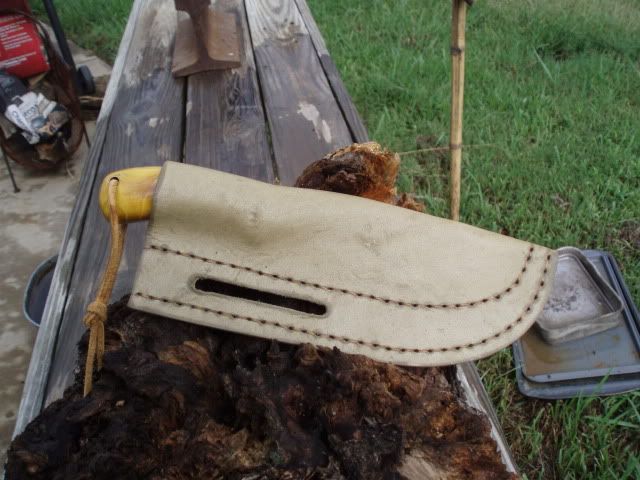I got this one a little while back, and it's exactly what I'd hoped for (a classic, rustic-esque Nessmuk):




Farrier's rasp blade, osage orange scales.
9 3/8" OAL
4 3/4" blade OAL
1 9/16" at the deepest part of the belly
1 1/4" at the base of the blade
About 3/16" thick
About 10 oz weight
Convex grind (nice), and razor sharp..
First field use of this knife, and the Nessmuk design, was yesterday. The test subjects were a nice, fresh version of Surf & Turf (early season Southern hillbilly style

):


Gotta say, I'm impressed on both accounts, both with the design and the craftsmanship

First off, it's a big knife, and heavy. Not cumbersome, just big. That, however, plays a part in it's utility.
To say the farrier's rasp blade with convex edge is sharp, would be an understatement. And, it's a durable edge, both in retention and in beef/use.
The test I gave it was one that would be likely one of the more difficult for a knife of this size and design, but one that would arguably see the most use. That is, processing small game and fish.
Now, obviously, this is no bird and trout design. And that, was exactly the point of this test.
I have to say, it handled it superbly.
The squirrels were first, and I processed them the "old way"; a cut along the low back through the hide, then pull the hide off as a "shirt and pair of pants". The cut was made easily, as would be with a very sharp blade.
The next step was the one where the weight and blade shape started showing a surprising degree of merit. As you can see, the blade is a bit like a heavy Santuko, or small cleaver. And, it has enough weight to do exactly that. A swift chop, and accurately delivered due to the balance, and the head, legs, and tail were easily removed. The cleaver and weight characteristic was a surprise, and a satisfying one.
The same attribute showed when removing heads from the fish a few minutes later.
On both the fish and squirrels, the knife had just enough point to open the cavity to remove entrails, and plenty enough drop point to keep the cavity from being punctured. Again, the sharpness of the blade shown through, and made fast work of the slitting process.
The scaling of fish was an afterthought with the blade, but it handled it with aplomb. The convex edge did not make this work as easy as a thin, flat grind, but it worked plenty well enough.
Overall, I can quickly see the efficiency and the utility of the Nessmuk design, and this version is well done.
It's not a fancy design, nor a fancy design or execution. It wasn't intended to be. What is it, is a heavy using knife, well crafted and thought out, well executed, and it's functionality shows in the field. Where it counts.
I have quite a few other custom knives. All have their advantages, and all are favorites. This Nessmuk is a very worthwhile addition to the list.


